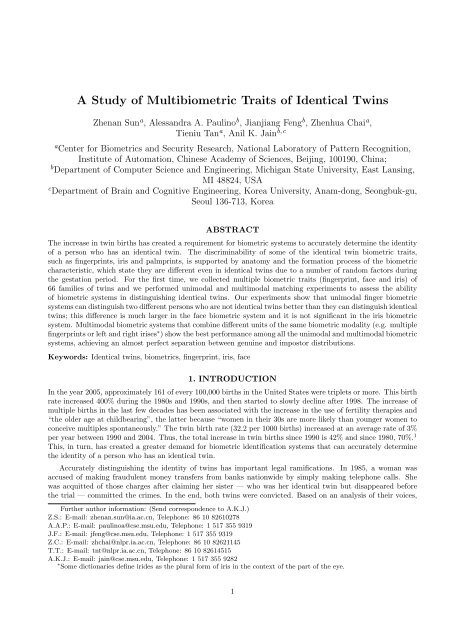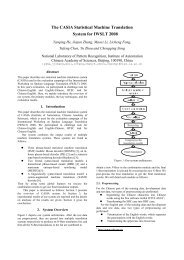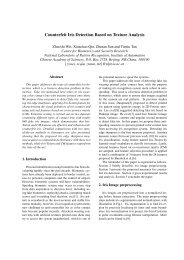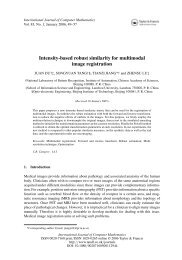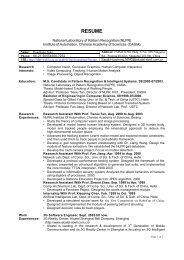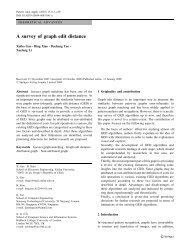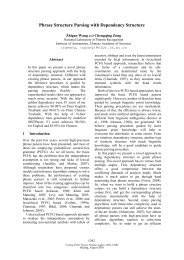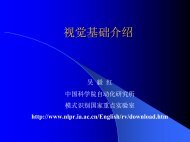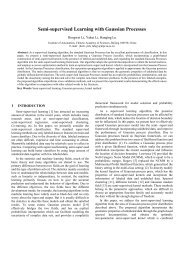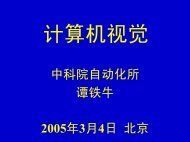A Study of Multibiometric Traits of Identical Twins
A Study of Multibiometric Traits of Identical Twins
A Study of Multibiometric Traits of Identical Twins
- No tags were found...
You also want an ePaper? Increase the reach of your titles
YUMPU automatically turns print PDFs into web optimized ePapers that Google loves.
A <strong>Study</strong> <strong>of</strong> <strong>Multibiometric</strong> <strong>Traits</strong> <strong>of</strong> <strong>Identical</strong> <strong>Twins</strong>Zhenan Sun a , Alessandra A. Paulino b , Jianjiang Feng b , Zhenhua Chai a ,Tieniu Tan a , Anil K. Jain b,ca Center for Biometrics and Security Research, National Laboratory <strong>of</strong> Pattern Recognition,Institute <strong>of</strong> Automation, Chinese Academy <strong>of</strong> Sciences, Beijing, 100190, China;b Department <strong>of</strong> Computer Science and Engineering, Michigan State University, East Lansing,MI 48824, USAc Department <strong>of</strong> Brain and Cognitive Engineering, Korea University, Anam-dong, Seongbuk-gu,Seoul 136-713, KoreaABSTRACTThe increase in twin births has created a requirement for biometric systems to accurately determine the identity<strong>of</strong> a person who has an identical twin. The discriminability <strong>of</strong> some <strong>of</strong> the identical twin biometric traits,such as fingerprints, iris and palmprints, is supported by anatomy and the formation process <strong>of</strong> the biometriccharacteristic, which state they are different even in identical twins due to a number <strong>of</strong> random factors duringthe gestation period. For the first time, we collected multiple biometric traits (fingerprint, face and iris) <strong>of</strong>66 families <strong>of</strong> twins and we performed unimodal and multimodal matching experiments to assess the ability<strong>of</strong> biometric systems in distinguishing identical twins. Our experiments show that unimodal finger biometricsystems can distinguish two different persons who are not identical twins better than they can distinguish identicaltwins; this difference is much larger in the face biometric system and it is not significant in the iris biometricsystem. Multimodal biometric systems that combine different units <strong>of</strong> the same biometric modality (e.g. multiplefingerprints or left and right irises ∗ ) show the best performance among all the unimodal and multimodal biometricsystems, achieving an almost perfect separation between genuine and impostor distributions.Keywords: <strong>Identical</strong> twins, biometrics, fingerprint, iris, face1. INTRODUCTIONIn the year 2005, approximately 161 <strong>of</strong> every 100,000 births in the United States were triplets or more. This birthrate increased 400% during the 1980s and 1990s, and then started to slowly decline after 1998. The increase <strong>of</strong>multiple births in the last few decades has been associated with the increase in the use <strong>of</strong> fertility therapies and“the older age at childbearing”, the latter because “women in their 30s are more likely than younger women toconceive multiples spontaneously.” The twin birth rate (32.2 per 1000 births) increased at an average rate <strong>of</strong> 3%per year between 1990 and 2004. Thus, the total increase in twin births since 1990 is 42% and since 1980, 70%. 1This, in turn, has created a greater demand for biometric identification systems that can accurately determinethe identity <strong>of</strong> a person who has an identical twin.Accurately distinguishing the identity <strong>of</strong> twins has important legal ramifications. In 1985, a woman wasaccused <strong>of</strong> making fraudulent money transfers from banks nationwide by simply making telephone calls. Shewas acquitted <strong>of</strong> those charges after claiming her sister — who was her identical twin but disappeared beforethe trial — committed the crimes. In the end, both twins were convicted. Based on an analysis <strong>of</strong> their voices,Further author information: (Send correspondence to A.K.J.)Z.S.: E-mail: zhenan.sun@ia.ac.cn, Telephone: 86 10 82610278A.A.P.: E-mail: paulinoa@cse.msu.edu, Telephone: 1 517 355 9319J.F.: E-mail: jfeng@cse.msu.edu, Telephone: 1 517 355 9319Z.C.: E-mail: zhchai@nlpr.ia.ac.cn, Telephone: 86 10 82621145T.T.: E-mail: tnt@nlpr.ia.ac.cn, Telephone: 86 10 82614515A.K.J.: E-mail: jain@cse.msu.edu, Telephone: 1 517 355 9282∗ Some dictionaries define irides as the plural form <strong>of</strong> iris in the context <strong>of</strong> the part <strong>of</strong> the eye.1
However, in many previous work, the identical twin biometric databases are very small and inhouse biometricmatchers instead <strong>of</strong> the state-<strong>of</strong>-the-art matchers are used. This affects the reliability <strong>of</strong> conclusions. Moreover,no study has been conducted to compare and fuse multiple biometric traits <strong>of</strong> identical twins.3. MULTIBIOMETRICSA multibiometric system uses multiple sources <strong>of</strong> biometric information in order to recognize an individual. Forexample, a multibiometric system may use fingerprint and face, the left and right iris, or a fusion <strong>of</strong> differentfingerprint matching algorithms to recognize a person. In the next subsections, we focus our attention on thedistinctiveness <strong>of</strong> fingerprints, face, and iris for identical twins. These three modalities will be used in ourmultibiometric experiments.3.1 Fingerprint DiscriminabilityA fingerprint is the impression <strong>of</strong> the friction skin on a finger. The individual characteristics <strong>of</strong> friction ridgeskin are determined during fetal development. Their formation is similar to the formation <strong>of</strong> blood vessels orcapillaries during the growth <strong>of</strong> the fetus in the uterus. The fingerprint formation starts at approximately 6 or 7weeks <strong>of</strong> gestational age and it is due to the flow <strong>of</strong> amniotic fluids in a micro-environment. 14 A minor change inthis flow and in the position <strong>of</strong> the fetus in the uterus cause the minute skin structures around palm or finger tipsto differentiate. Friction ridge skin can be distinguished from the skin <strong>of</strong> the rest <strong>of</strong> the body due to a variety <strong>of</strong>factors, such as the presence <strong>of</strong> raised ridges, increased sensory abilities, absence <strong>of</strong> hair and sebaceous glands,and a thicker and more complex epidermis. Friction ridges are related to grasping and gripping, which explainstheir presence in our hands and feet.A fingerprint pattern has some details inherent to each individual like ridge endings, the point where aridge ends abruptly, or a ridge bifurcation or trifurcation, where the ridges are divided into different branches.These details are called minutiae points and they are supposedly different in every fingerprint, even in prints <strong>of</strong>identical twins, because, as mentioned before, a very small difference in micro-environment is sufficient to changethe process <strong>of</strong> cell formation, causing minutiae points to be different. As a result, fingerprint is considered veryreliable in terms <strong>of</strong> biometric identification because <strong>of</strong> its distinctiveness. Another reason for this reliability isthat fingerprints do not change significantly over time, an essential characteristic <strong>of</strong> a biometric modality sincea biometric system is typically meant to be used to identify a person over a long period <strong>of</strong> time.A friction ridge pattern consists <strong>of</strong> three levels <strong>of</strong> detail, which are used for fingerprint matching: ridge flowand pattern (level 1 features), ridge path and minutiae (level 2 features), and dimensional, edge shape and poredetails within a specific ridge (level 3 features). Ridge flow pattern falls into three general categories: whorls,in which the ridge flows form a complete circuit; loops, in which the ridge flow enters from one side <strong>of</strong> thefingerprint, curves and returns in the same direction from which it came; and arches, in which the ridge flowenters from one side and exits the opposite side. In the second level features, ridges vary in length, and canbe dots, which are very short ridges containing just one pore, or they can cross the entire area <strong>of</strong> friction skinwithout being broken. An example <strong>of</strong> the third level feature is the sweat pores that are regularly spaced alongthe ridges and whose specific locations and shape can be used as distinctive features for identification. 143.2 Face DiscriminabilityFace is composed <strong>of</strong> the skull characteristics and the musculature and associated s<strong>of</strong>t tissue. To study thevariation among human faces it is necessary to study these structures. The facial skeleton serves as the bonyframework for the mimetic musculature. Since these muscles are stretched across the facial skeleton like amask, the variation in facial appearance is caused mostly because <strong>of</strong> the form <strong>of</strong> the facial bones. A majority<strong>of</strong> individuals can be divided in three categories in terms <strong>of</strong> facial appearance: (i) a long, narrow head, (ii) aproportional length to width head and (iii) a short, wide head; these differences in facial shapes are due to theform <strong>of</strong> the cranial base. 14Facial form is influenced by gender. Males are more likely to have larger faces because <strong>of</strong> their usually largerbodies and their need <strong>of</strong> more air in order to support larger muscles and visceras, causing them to also havea larger nose. Males usually have a more protrusive forehead. Besides the gender influences in the face <strong>of</strong> an4
individual, a face also changes when a person ages. Infant faces tends to be wide and short because <strong>of</strong> thedevelopment <strong>of</strong> the brain; over time, the face develops and this wide and short face tends to change. Othereffects <strong>of</strong> aging are dehydration <strong>of</strong> the dermis and reabsorption <strong>of</strong> subcutaneous fat deposits, which result in adecrease in the facial volume and wrinkling. 14The muscles may vary in their presence (not everyone has all the muscles that could be in a face), form,location, and control. These factors influence the kind <strong>of</strong> facial movement that an individual can create. Furthermore,the facial movements <strong>of</strong> an individual change his/her face as he/she ages. With aging, the elasticity<strong>of</strong> the skin decreases and the face then is marked with the expressions that occur frequently, becoming relativelypermanent features. This fact may explain why identical twin faces are more likely to be distinguished as theyare older than when they are infants. 14There are a number <strong>of</strong> factors that influence the performance <strong>of</strong> a facial recognition system. Besides thosealready cited above, there are differences in pose, illumination, expression, occlusion, accessories like glasses,weight changes, hair style changes, etc. All these variations make facial recognition systems not as accurate assome other biometrics, like fingerprints. <strong>Identical</strong> twins present a very difficult situation for face recognitionsystems, since they are usually very similar in facial appearance.3.3 Iris DiscriminabilityThe iris is an annular shaped part <strong>of</strong> the eye between the pupil and the sclera that regulates the amount <strong>of</strong>light entering the eye through the pupil. Iris is physically small in size (about 11 mm) but well designed opticalsystems can magnify a human iris into a high-resolution image with 200 to 300 pixels in diameter. There aremany minute features such as freckles, coronas, stripes, furrows and crypts, etc. randomly distributed in theiris region, which constitute the unique iris texture for each eye. It should be noted that the visual pattern <strong>of</strong> ahuman iris includes both color and texture. However, iris color has limited discriminating power for recognition.So gray-level iris images captured under near infrared illumination are <strong>of</strong>ten used to record iris texture patternfor person identification.The iris texture pattern is formed and becomes stable after the eighth month <strong>of</strong> gestation. It is commonlybelieved that the formation <strong>of</strong> iris pattern is determined by the gestation environment, i.e. iris is a phenotypicbiometrics. 8 So even identical twins can be discriminated using suitable iris features; even the iris <strong>of</strong> left andright eyes <strong>of</strong> the same person are different.Random processes involved in iris development determine the irregular shape and random spatial layout <strong>of</strong>micro anatomical structures (MAS). The MAS in the iris surface may exhibit different reflectance properties innear infrared light, leading to sharp intensity variations across iris image region. We can regard each iris region asa piece <strong>of</strong> 2D surface in a 3D coordinate system. So the surface shape from valley to peak resembles an odd Gaborfilter and the shape from valley to peak then valley resembles an even Gabor filter, and vice versa. Daugman 8proposed to match each iris region with even or odd Gabor filters and then encode positive correlation as 1 andnegative correlation as 0. This way, an iris image can be represented by 256 bytes, called the iris code. Theiris codes <strong>of</strong> twins (or non-twins) have only 50% chance <strong>of</strong> being matched because their corresponding regionsindependently have an equal probability to be either 1 or 0 in iris feature coding. In contrast, multiple iris images<strong>of</strong> the same eye have a much higher probability than 50% to be matched in their iris codes, even though noisemay perturb some parts <strong>of</strong> iris codes. A more general explanation <strong>of</strong> the effectiveness <strong>of</strong> iris recognition for twinsis based on ordinal measures. 154. EXPERIMENTAL RESULTS AND ANALYSISThe first version <strong>of</strong> the CASIA Multimodal Biometrics Database <strong>of</strong> <strong>Twins</strong> (CASIA-<strong>Twins</strong>V1) was collected onOctober 2, 2007 at the Beijing Chaoyang Park during the Fourth Annual Festival <strong>of</strong> Beijing <strong>Twins</strong> Day. Figure1(a) shows the kiosk where the biometric acquisition was performed and Figure 1(b) shows the face acquisitiondevice. This database includes face, iris, and fingerprint images from 92 pairs <strong>of</strong> twins and 2 sets <strong>of</strong> triplets. Allthe images were captured indoors on the same day (i. e., single data capture session).Not all <strong>of</strong> the 94 families provided images for all the modalities. Since later our experiments would involvecombinations <strong>of</strong> units/modalities, we considered only those individuals who have a complete set <strong>of</strong> images (face,5
(a)Figure 1. The kiosk for biometric acquisition (a) and the face acquisition device (b).(b)two irises and four fingerprints) in the database, and whose twin’s images were also present in the database asa complete set. As a result, the total number <strong>of</strong> subjects used in our experiments consisted <strong>of</strong> 134 subjects (66families, including two families <strong>of</strong> triplets — 51 pairs <strong>of</strong> identical twins and 15 pairs <strong>of</strong> non-identical twins). Forall units (four fingers, two irises and face), the number <strong>of</strong> genuine matches performed was 134, the number <strong>of</strong>identical twin impostor matches was 102, and the number <strong>of</strong> general impostor matches was 17,720.Most <strong>of</strong> the twins are identical (or monozygotic twins), but some are non-identical (or dizygotic) twins. Thisinformation was not recorded, so we derived this information based on observing whether the facial images <strong>of</strong> aset <strong>of</strong> twins were very similar or not † . We divided our database into two groups, identical twins and non-identicaltwins. Most <strong>of</strong> the subjects in the database are children, but there are some adults as well. The subject ageranges from 5 to 65, with the average age being 16.8. In the following sections, we present detailed descriptions<strong>of</strong> the databases used, the experiments performed, and experimental results.4.1 FingerprintThe fingerprint images were captured using Symwave sw6888, 16 a sweep sensor, with a resolution <strong>of</strong> 500 dpi.This dataset contains images from four different fingers and the number <strong>of</strong> images per finger is not fixed, butvaries from 6 to 31. Because <strong>of</strong> this large variability and the poor quality <strong>of</strong> many images, we selected one imageper finger as the template and another image from the same finger as the query image that contain the largestnumber <strong>of</strong> minutiae.Figure 2 shows some fingerprint images from the twin dataset. Figure 2(a) shows images <strong>of</strong> the four fingers1, 2, 3, and 4 for the first twins <strong>of</strong> an identical twin pair; Figure 2(b) shows the fingerprints <strong>of</strong> the correspondingfingers for the second twins <strong>of</strong> the pair. Figures 2(c) and 2(d) follow the same scheme for a non-identical twinpair. The similarity between ridge flow patterns <strong>of</strong> corresponding fingers <strong>of</strong> identical twins is evident. While allfour pairs <strong>of</strong> corresponding fingers <strong>of</strong> identical twins have the same fingerprint pattern type, only two pairs <strong>of</strong>corresponding fingers <strong>of</strong> non-identical twins have the same pattern type.A commercial minutiae based matcher, VeriFinger, 17 was used to obtain the matching score in the fingerprintexperiments.Three distributions were generated in order to observe the results <strong>of</strong> the experiments. The genuine distributionwas obtained by matching the gallery image <strong>of</strong> one modality <strong>of</strong> one individual to the probe image <strong>of</strong> the samemodality and the same individual. <strong>Identical</strong> twin impostor distribution was generated by matching each image<strong>of</strong> one person to his/her identical twin. The general impostor distribution was generated by all the impostormatches except the identical impostor matches described above. This scheme was used for all the experiments.Figures 5(a) and 5(b) show the genuine, identical twin and the general impostor distributions <strong>of</strong> finger 3,which had the worst performance among the four fingers, and finger 4, the best performing finger, respectively.† The ideal method to distinguish identical or non-identical twins should be based on DNA.6
(a)(b)(c)Figure 2. Fingerprint images <strong>of</strong> fingers 1, 2, 3, and 4 <strong>of</strong> the first twin (a), and the four images <strong>of</strong> the corresponding fingers<strong>of</strong> an identical twin pair (b); similarly, (c) and (d) show fingerprint images <strong>of</strong> a non-identical twin pair. Note the similarityin ridge flow pattern between identical twins. All four corresponding fingers <strong>of</strong> identical twins in (a) and (b) have thesame pattern. But for non-identical twins in (c) and (d), only two corresponding fingers (no. 1 and 3) have the samepattern.(d)We can see that, although identical twin impostor distribution <strong>of</strong> finger no. 3 is similar to the general impostordistribution <strong>of</strong> this same finger, there are some peaks in the right tail <strong>of</strong> the identical twin impostor distributionthat differentiates them. This is an indicative <strong>of</strong> the larger similarity between fingerprints <strong>of</strong> identical twinscompared to the similarity between fingerprints <strong>of</strong> unrelated persons. This is also the case for finger no. 4.4.2 FaceThe facial images were captured in color, all <strong>of</strong> them from a USB camera. The image size is 480×640, but theface area varies from 280×300 to 300×400. The images contain non-uniform background, and some variationsin illumination. The images were captured in a sequence and over a short time interval. There are about 20 faceimages per subject. Some facial image examples are shown in Figure 3. The first two images show facial images<strong>of</strong> an identical twin pair (Figure 3(a)), while the other two are facial images <strong>of</strong> a non-identical twin pair (Figure3(b)).(a)Figure 3. Facial images <strong>of</strong> the first and second twin in an identical twin pair (a), and a non-identical twin pair (b).The face subset used in the experiments contained 134 subjects, each one having around 20 images. Thecommercial matcher used to perform the facial matchings was FaceVACS. 18 We considered two facial imagesper person (the template and the query) in our experiment, mainly because the pictures were taken over a veryshort time interval, which makes them very similar. The first and the last images <strong>of</strong> each person were used, since(b)7
they are expected to be the least similar. Figure 5(c) shows identical twin and general impostor distributions,along with the genuine distribution for the face experiments. In the genuine distribution, we can see that thereis almost no tail and that about 90% <strong>of</strong> the genuine matches has a score <strong>of</strong> more than 0.95. This is due to thehigh similarity between the two images <strong>of</strong> the same person, since they were taken in sequence and in a very shorttime interval. Also, we can observe that the identical twin impostor distribution is much more similar to thegenuine distribution than to the general impostor distributions, meaning identical twins are a real challenge t<strong>of</strong>ace recognition systems.4.3 IrisThe iris images were captured using a IKEMB-100 camera produced by IrisKing. 19 The size <strong>of</strong> the images is480×640, but the approximate iris diameter is 200 pixels. It is an embedded dual-eye iris camera and has aLCD displaying real time iris images for user convenience. The iris images were captured in sequence and overa short time interval. There are 10 images for most <strong>of</strong> the subjects, with a few individuals having a smallernumber <strong>of</strong> images. Some examples <strong>of</strong> iris images are shown in Figure 4. Figures 4(a) and 4(b) show iris images<strong>of</strong> an identical twin pair, where the two images in 4(a) are the left and right iris images <strong>of</strong> the first twin, and thetwo images in 4(b) are the left an right iris images <strong>of</strong> the second twin. Similarly, Figures 4(c) and 4(d) show irisimages <strong>of</strong> a non-identical twin pair.(a)(b)(c)Figure 4. The left and right iris images <strong>of</strong> identical ((a) and (b)) and non-identical twin pairs ((c) and (d)).The iris feature representation method based on ordinal measures 15 is used to test the performance <strong>of</strong> irisrecognition for twins. Two iris images were randomly selected as probe and gallery for each eye. Figure 5(d) showsthe genuine, identical twin and general impostor distributions <strong>of</strong> the right iris, which performed slightly betterthan the left iris. The identical twin impostor distribution is very similar to the general impostor distribution.However, the peaks that are present in the identical twin impostor distribution tail may indicate that the irises<strong>of</strong> identical twins have some correlation.4.4 <strong>Multibiometric</strong> Experimental ResultsIn our multibiometric experiments, we first combined units <strong>of</strong> the same modality, like the two irises or all thefour fingers <strong>of</strong> a person. We performed a simple fusion using scores from the four fingers by summing them.The identical twin and general impostor distributions, along with the genuine distributions are shown in Figure(d)8
1Fingerprint Results − ROC Curves1Iris Results − ROC CurvesTrue Acceptance Rate (TAR)0.950.90.85Finger 3 − <strong>Identical</strong> Twin ImpostorFinger 3 − General Impostor0.8Finger 4 − <strong>Identical</strong> Twin ImpostorFinger 4 − General Impostor4−finger fusion − <strong>Identical</strong> Twin Impostor4−finger fusion − General Impostor0.7510 −4 10 −3 10 −2 10 −1 10 0False Acceptance Rate (FAR)(a) FingerprintTrue Acceptance Rate (TAR)0.950.90.85Left Iris − <strong>Identical</strong> Twin ImpostorLeft Iris − General Impostor0.8Right Iris − <strong>Identical</strong> Twin ImpostorRight Iris − General ImpostorFusion − <strong>Identical</strong> Twin ImpostorFusion − General Impostor0.7510 −4 10 −3 10 −2 10 −1 10 0False Acceptance Rate (FAR)(b) Iris1FaceResults − ROC − Face1Fusion Results − ROC Curve − Face + Finger 40.950.95True Acceptance Rate (TAR)0.90.85True Acceptance Rate (TAR)0.90.850.80.8<strong>Identical</strong> Twin ImpostorsGeneral Impostors0.7510 −4 10 −3 10 −2 10 −1 10 0False Acceptance Rate (FAR)<strong>Identical</strong> Twin ImpostorsGeneral Impostors0.7510 −4 10 −3 10 −2 10 −1 10 0False Acceptance Rate (FAR)(c) Face(d) Multimodal FusionFigure 7. ROC curves for fingerprint, iris and face, and a fusion example (face + finger 4). Due to the small number <strong>of</strong>identical twin impostor (102), FAR less than 1/102 cannot be estimated.systems combining different modalities show improvements in the performance on the general data compared toboth modalities that are being combined, and drops in the performance on the identical twin data comparedto the highest performance modality that is being combined. So, despite the fact that a combination <strong>of</strong> twodifferent modalities is using more information, the performance on the identical twin data shows no improvementcompared to the highest performance modality.To our knowledge, although multibiometric databases for twins have been collected before (the ten fingersand/or the two palmprints), nobody has combined different units/modalities to study the multibiometric performance.We performed multibiometric experiments and showed that the performance <strong>of</strong> a multibiometric systemthat uses different units <strong>of</strong> the same modality does improve compared to unimodal systems, reaching almostperfect results on our database. Also, there have not been any previous studies <strong>of</strong> identical twin irises with adatabase this large. In addition, we have used commercial matchers for the face and fingerprint experiments,which are usually more accurate than inhouse matchers (used in previous studies). Based on this, for example, wecan conclude that the presence <strong>of</strong> identical twin data poses a real challenge to existing face recognition systems.11
ACKNOWLEDGMENTSAnil Jain’s research was partially supported by WCU (World Class University) program through the National ResearchFoundation <strong>of</strong> Korea funded by the Ministry <strong>of</strong> Education, Science and Technology(R31-2008-000-10008-0). Alessandra Paulino’s research was supported by Fulbright Program (A15087649) and Brazilian Governmentthrough a CAPES Foundation/Ministry <strong>of</strong> Education grant (1667-07-6). This research was also supported inpart by the National Basic Research Program <strong>of</strong> China (Grant No. 2004CB318110), Natural Science Foundation<strong>of</strong> China (Grant No. 60736018, 60702024), Hi-Tech Research and Development Program <strong>of</strong> China (GrantNo.2006AA01Z193, 2007AA01Z162) and the Chinese Academy <strong>of</strong> Sciences.REFERENCES[1] Martin, J. A., Kung, H.-C., Mathews, T. J., Hoyert, D. L., Strobino, D. M., Guyer, B., and Sutton, S. R.,“Annual summary <strong>of</strong> vital statistics: 2006,” Pediatrics , 788–801 (2008).[2] UPI, “<strong>Identical</strong> twins guilty in bank fraud scheme,” United Press International , 1756–1766 (September 24,1986). Section: Domestic News.[3] “Twin convicted in third rape trial,” (March 22, 2006).http://origin.foxnews.com/story/0,2933,188801,00.html.[4] Jain, A. K., Prabhakar, S., and Pankanti, S., “On the similarity <strong>of</strong> identical twin fingerprints,” PatternRecognition 35, 2653–2663 (2002).[5] Kong, A. W.-K., Zhang, D., and Lu, G., “A study <strong>of</strong> identical twins’ palmprints for personal verification,”Pattern Recognition 39, 2149–2156 (2006).[6] Kodate, K., Inaba, R., Watanabe, E., and Kamiya, T., “Facial recognition by a compact parallel opticalcorrelator,” Measurement Science and Technology 13, 1756–1766 (2002).[7] Ariyaeeinia, A., Morrison, C., Malegaonkar, A., and Black, S., “A test <strong>of</strong> the effectiveness <strong>of</strong> speakerverification for differentiating between identical twins,” Science and Justice 48, 182–186 (2008).[8] Daugman, J. and Downing, C., “Epigenetic randomness, complexity and singularity <strong>of</strong> human iris patterns,”in [Proceedings <strong>of</strong> the Royal Society <strong>of</strong> London], 268, 1737–1740 (2001).[9] Han, Y., Ryu, C., Moon, J., Kim, H., and Choi, H., “A study on evaluating the uniqueness <strong>of</strong> fingerprintsusing statistical analysis,” in [Proceedings <strong>of</strong> the International Conference on Information Security andCryptology], 467–477 (2005).[10] Srihari, S. N., Srinivasan, H., and Fang, G., “Discriminability <strong>of</strong> fingerprints <strong>of</strong> twins,” Journal <strong>of</strong> ForensicIdentification 58(1), 109–127 (2008).[11] Bronstein, A. M., Bronstein, M. M., and Kimmel, R., “Three-dimensional face recognition,” InternationalJournal <strong>of</strong> Computer Vision 64(1), 5–30 (2005).[12] Lytle, J. M., “Biometric face scanner tells identical twins apart,” (May 9th 2008).http://www.techradar.com/news/world-<strong>of</strong>-tech/future-tech/face-scanner-tells-identicaltwins-apart-363150.[13] Patil, H. A. and Basu, T. K., “The teager energy based features for identification <strong>of</strong> identical twins in multilingualenvironment,” in [Proceedings <strong>of</strong> the International Conference on Neural Information Processing],333–337 (2004).[14] Li, S. Z., ed., [Encyclopedia <strong>of</strong> Biometrics], vol. 1, Springer Science + Business Media (2009). EditorialAdvisor: Anil Jain.[15] Sun, Z. and Tan, T., “Ordinal measures for iris recognition,” IEEE Transactions on Pattern Analysis andMachine Intelligence . in press.[16] “Symwave: BioPrint USB Portable and Peripheral Solutions.” http://www.symwave.com/docs/SW6888-FPSecure productbrief.pdf.[17] “Neurotechnology: VeriFinger SDK.” http://www.neurotechnology.com/verifinger.html.[18] “Cognitec: FaceVACS - SDK.” http://www.cognitec-systems.de/FaceVACS-SDK.19.0.html.[19] “SDK-Beijing IrisKing Ltd. Co..” www.irisking.com/en/sdk.html.12


